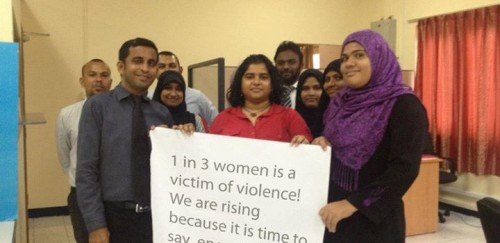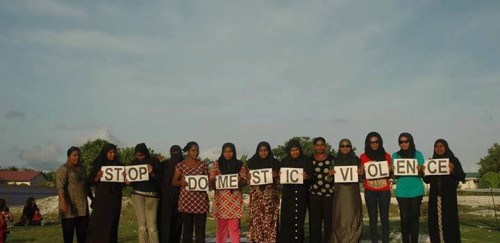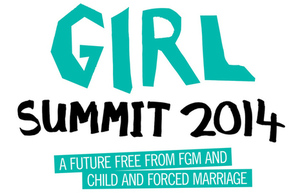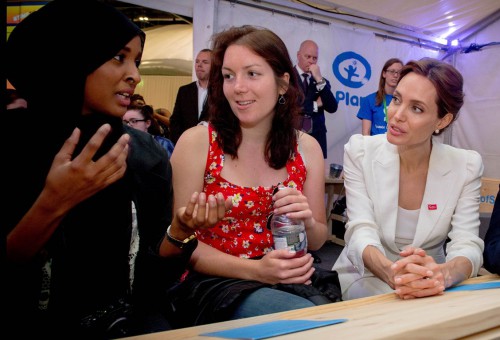25th November 2014 Colombo, Sri Lanka
Eliminating Violence Against Women: Two women take stock
Kofi Annnan described violence against women as a pandemic. Globally, one in three women will have experienced some form of violence. In some countries, that increases to 70%. Problems in both the UK and Sri Lanka are well documented – violence against women isn’t an issue of geography, culture or wealth.
 To mark the International Day for the Elimination of Violence Against Women I wanted to partner with others who feel as strongly. The reaction was so positive, that I’ve ended up with two blogs and a campaign.
To mark the International Day for the Elimination of Violence Against Women I wanted to partner with others who feel as strongly. The reaction was so positive, that I’ve ended up with two blogs and a campaign.
In this post, Sepali Kottegoda, Director of the Sri Lankan Women and Media Collective and Nazeefa Saeed from the Maldivian organisation Hope for Women take stock of our efforts so far. The second post is written by Senel Wanniarachchi, one of Sri Lanka’s delegates to the 69th UN Youth General Assembly. He talks passionately about why violence against women is also a men’s issue.
Society is often reluctant to speak up: even across the European Union, only 13% of women report violence against them to the police. That’s why the British High Commission is supporting UN Women’s #orangeurworld campaign for 16 days of activism leading up to World Human Rights Day on 10 December: to stand up and be counted, tweet or send us photos of yourselves in orange.
Progress is evident! But is it enough? By Nafeeza Saeed
“ 1 in 3” is a well-understood phrase in the Maldives. It captures the prevalence of violence against women in the Maldives as revealed in the 2007 Maldives Study of Women’s Health and Life Experiences. According to the study, more than 1 in 3 women in the Maldives, between the ages of 15 – 49 experience some sort of physical or sexual violence, or both, during their life time. When this study came out it forced everybody to reckon with this ubiquitous issue.
Gender activists, women’s groups and organisations in the country rode on the moment. They mobilised to advocate on gender related issues and strengthen the domestic legislative framework’s ability to address and respond to violence against women. This led to the creation of the Gender Advocacy Working Group (GAWG) in 2010 to lobby for the passing of domestic violence legislation.

The Domestic Violence Act was ratified in April 2012. It defines domestic violence, categorizes it as an offence and mandates the state to take steps to prevent it as well as provide support and protection for survivors, and establishes a response coordination and monitoring mechanism.
Two years since the Act’s ratification, and as part of the 16 days of activism, the GAWG will be conducting a stock taking exercise of the legislation to assess the level of implementation and identify gaps and challenges to effectively translating the provisions of the Act into meaningful change in people’s lives.
The Act is a milestone! However the emergence of conservative ideologies, the lag in women’s economic and political participation is worrying. It forces us to make a paradigm shift! Protection is great, but without an increase in women’s agency, there cannot be an end to violence against women. Such a shift will enable us to move beyond protection and adopt a holistic approach that in addition to protection also focuses on empowerment and giving agency to end violence against women.
Recognising Intersectionality by Sepali Kottegoda
In Sri Lanka, high gender equality related indicators in education and health are marred by reports of high levels of violence against women and girls. This apparent contradiction explains why the many strategies being undertaken need to be better ‘synchronized’.
 Legal provisions that provide recourse to victims and punish perpetrators are an essential component of the accountability of the state to its citizens. A parallel policy initiative has been to set up women and children’s desks at police stations around the country. Specific policies, such as in the health sector, activities initiated by many women’s organizations, community based interventions have all raised awareness and helped make specific services available to victims. Mass media is both criticized as acting irresponsibly in perpetuating violence and also recognized and engaged with as a means to communicating messages on social responsibility. The issue is that most such interventions tend to run on linear trajectories.
Legal provisions that provide recourse to victims and punish perpetrators are an essential component of the accountability of the state to its citizens. A parallel policy initiative has been to set up women and children’s desks at police stations around the country. Specific policies, such as in the health sector, activities initiated by many women’s organizations, community based interventions have all raised awareness and helped make specific services available to victims. Mass media is both criticized as acting irresponsibly in perpetuating violence and also recognized and engaged with as a means to communicating messages on social responsibility. The issue is that most such interventions tend to run on linear trajectories.
It is the multi-dimensional nature of violence against women that is probably the most challenging for effective outcomes of the many interventions, laws, policies and strategies that are put into effect. VAW is characterized by intersectionality; women and girls of all ages carry with them identities of ethnicity, caste, religion, sexuality, economic status, geographical location, positioning within their homes (daughter, mother, grandmother, daughter in law, sister, aunt…), positioning in society in terms of marital status (single, married, separated, divorced, widowed).

We need a stronger articulation of the multi-dimensional nature of the issue of violence against women. A female who is a victim and/or survivor of gender based violence must be recognized in the complex web of identities she carries, if she and women in general are to find security in their homes, within their families, in the community and at the workplace.
very good ….
very nice ….